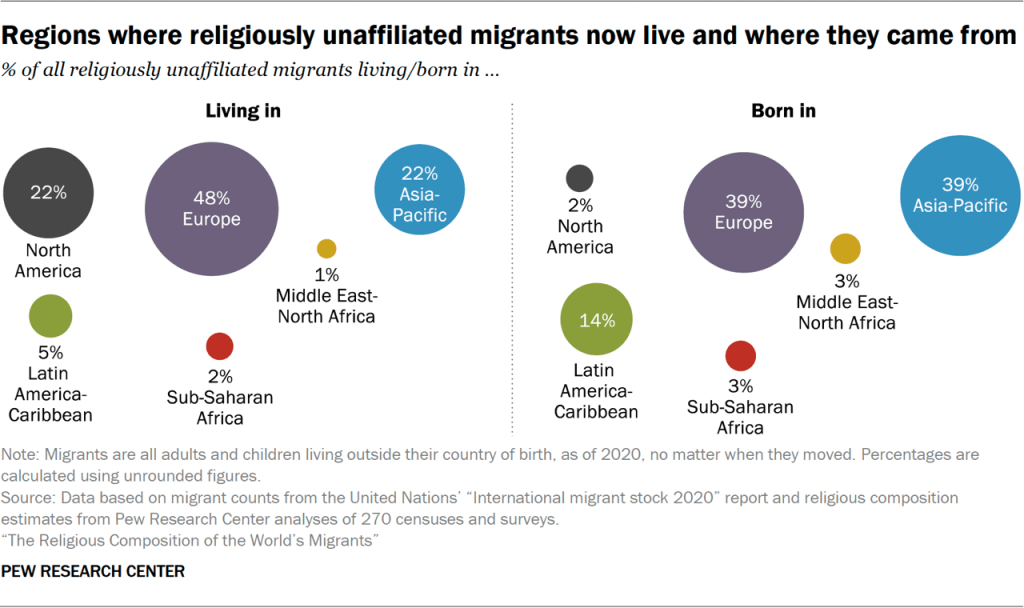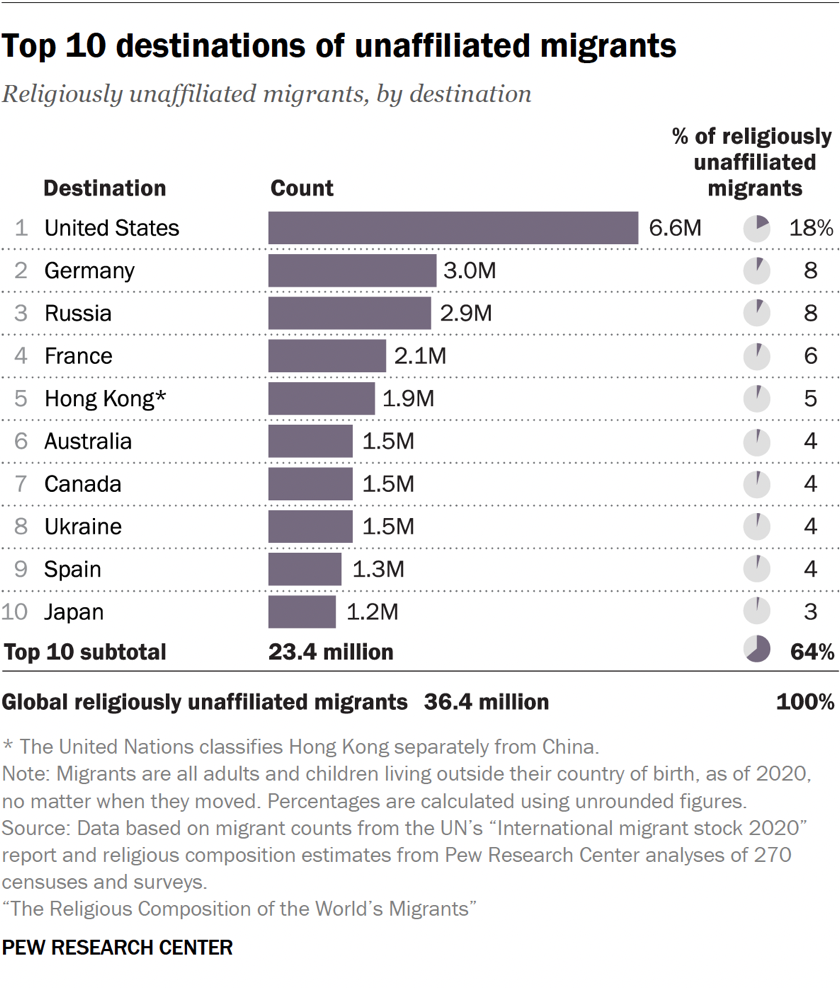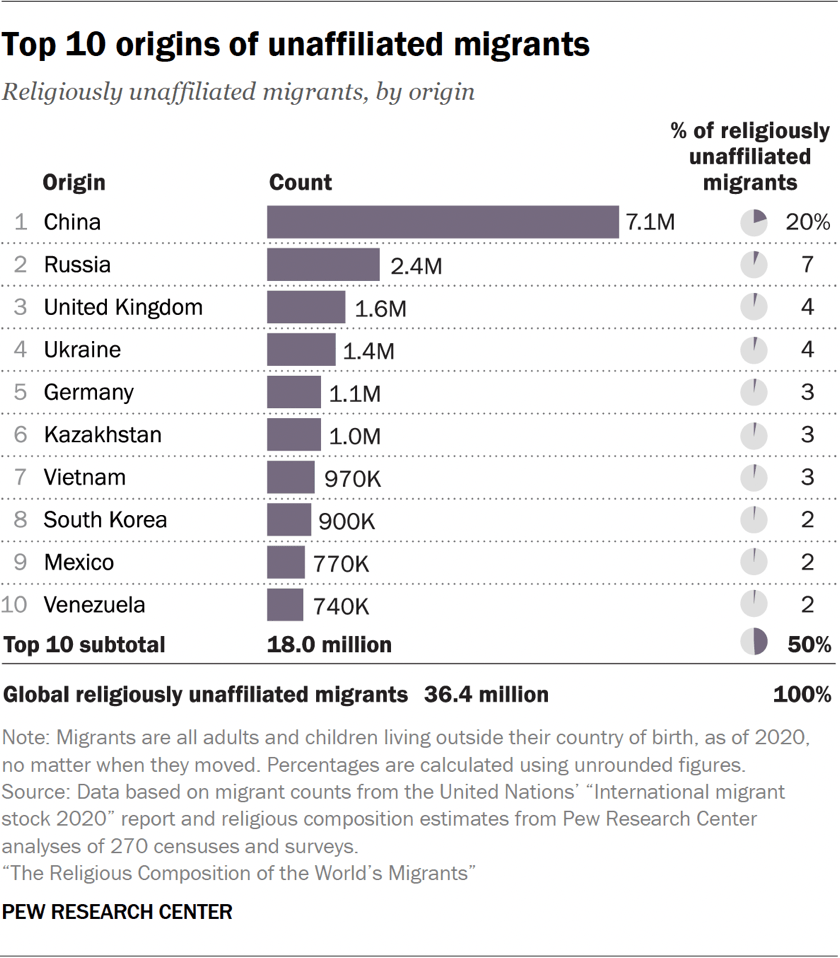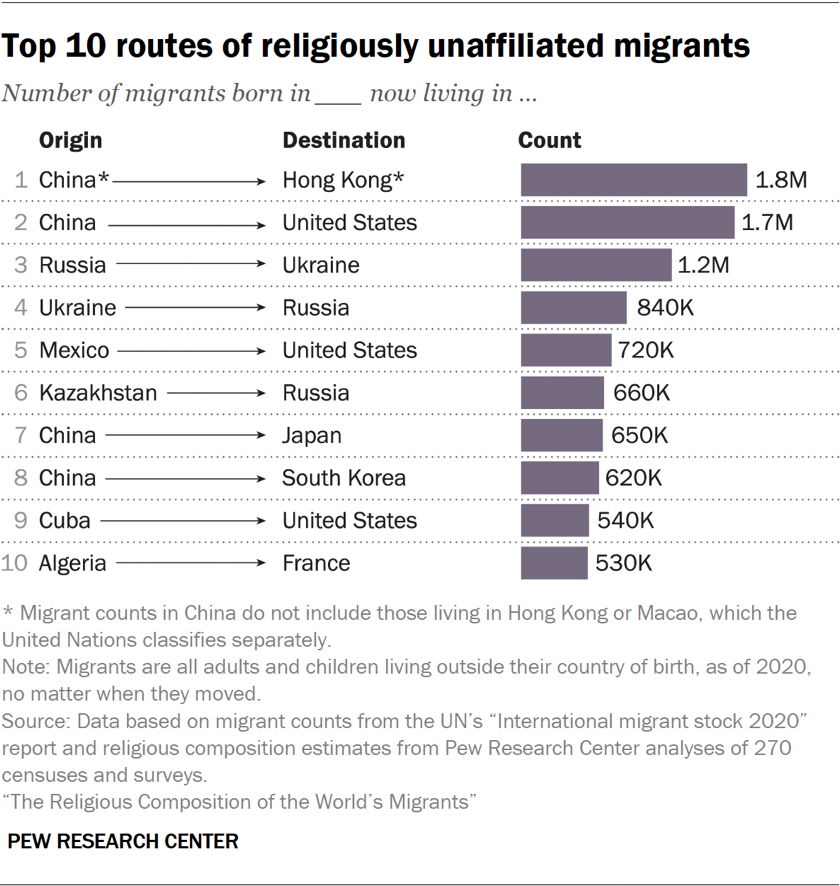The United Nations counts international migrants as people of any age who live outside their country (or in some cases, territory) of birth – regardless of their motives for migrating, their length of residence or their legal status.
In addition to naturalized citizens and permanent residents, the UN’s international migrant numbers include asylum-seekers and refugees, as well as people without official residence documents. The UN also includes some people who live in a country temporarily – like some students and guest workers – but it does not include short-term visitors like tourists, nor does it typically include military forces deployed abroad.
For brevity, this report refers to international migrants simply as migrants. Occasionally, we use the term immigrants to differentiate migrants living in a destination country from emigrants who have left an origin country. Every person who is living outside of his or her country of birth is all three – a migrant, an immigrant and an emigrant.
The analysis in this report focuses on existing stocks of international migrants – all people who now live outside their birth country, no matter when they left. We do not estimate migration flows – how many people move across borders in any single year.
More than 36 million international migrants are religiously unaffiliated – i.e. they say they have no religion or identify as atheist or agnostic. As of 2020, the religiously unaffiliated are underrepresented among migrants. They make up 13% of all people living outside their country of birth, but 23% of the general population.16
The religiously unaffiliated have moved an average of 2,500 miles from their countries of origin – about the same distance as Christian, Jewish and Buddhist migrants.
The lion’s share of migrants with no religious affiliation live in Europe (48%). Most of the rest are in North America (22%) and the Asia-Pacific region (22%), while only 5% live in Latin America and the Caribbean. Even smaller shares of unaffiliated migrants reside in sub-Saharan Africa or the Middle East and North Africa, two regions where rejecting religion is often frowned upon and sometimes forbidden by law.

Migrants of no religion are as likely to have been born in Asia and the Pacific as in Europe, with 39% coming from each of those regions. Another 14% come from the Latin America-Caribbean region. Very few were born in the Middle East and North Africa, sub-Saharan Africa or North America.
Destinations
Like other groups that have tended to move to places where many people share their religious identity, religiously unaffiliated migrants have gravitated to places where it is fairly common to have no religious affiliation.

More than a quarter of the world’s religiously unaffiliated migrants (6.6 million) have moved to the United States, making it their top destination. China is the top country of origin for unaffiliated migrants to the U.S., accounting for about 1.7 million.
But unaffiliated migrants make up just 13% of all migrants to the U.S., a far smaller share than the 30% of all Americans who were unaffiliated as of 2020.
In other words, migrants to the U.S. are less likely than the native-born U.S. population to be unaffiliated. As a result, migrants have slowed the decline of religious affiliation in the U.S.
Germany, home to 8% of religiously unaffiliated migrants (3 million), is their second-most common destination. Poland and Russia are the most common origin countries for unaffiliated migrants living in Germany.
Russia, close behind Germany, is the third-most common destination for unaffiliated migrants. Most unaffiliated migrants to Russia have come from nearby ex-Soviet republics, such as Ukraine and Kazakhstan.
Origins
The leading countries of origin for religiously unaffiliated migrants have large unaffiliated populations. The top two, China and Russia, have histories of state-sponsored atheism.

China – which in 2020 had more inhabitants than India and also had the world’s largest population of religiously unaffiliated people – is the most common country of origin for unaffiliated migrants. Nearly 20% of the world’s stock of unaffiliated migrants were born in China (7.1 million).
Nevertheless, migrants from China are less likely to be unaffiliated than are people living in China. About two-thirds of migrants from China are unaffiliated, compared with 90% of its total population. Some Chinese migrants did not have a formal religious identity until they adopted one in their destination country.17
Following distantly, Russia is the second-most common birth country for the world’s unaffiliated migrants (2.4 million). Most unaffiliated migrants from Russia have moved to Ukraine (1.2 million) or Germany (310,000).
The United Kingdom is the third-most common origin of unaffiliated migrants. The UK has a large native-born unaffiliated population. A majority of religiously unaffiliated migrants from the UK now live in other English-speaking countries, most commonly Australia, the U.S. and New Zealand.
Country pairs
The most common route for unaffiliated migrants has been from China to Hong Kong (which the United Nations classifies as separate from China). Nearly 2 million unaffiliated migrants have moved from mainland China to Hong Kong. The general populations in both places are largely religiously unaffiliated.

The second-most common pathway has been from China to the U.S. An estimated 1.7 million China-born unaffiliated migrants now live in the U.S.
As of 2020, Russia to Ukraine was the third-leading route for unaffiliated migrants (1.2 million), followed by movement in the other direction, from Ukraine to Russia (840,000). Both countries have large unaffiliated populations, though movement between them has, historically, also been common for other religious groups. The Russia-Ukraine war has changed migration patterns since 2022, leading to large migration flows out of Ukraine, due partly to forced migration.
Change since 1990
The global stock, or total number, of religiously unaffiliated people living outside their country of birth has grown from 21.8 million in 1990 to 36.4 million in 2020 (up 67%), which is lower than the estimated growth rate of international migrants overall (up 83%).
The U.S., Germany and Spain have experienced the largest influxes of unaffiliated migrants in recent decades. In the U.S., the stock of unaffiliated migrants has grown since 1990 from 3.4 million to 6.6 million (up 93%). In Germany, it has risen from 1.1 million to 3 million (a 162% rise), and in Spain it has jumped from 200,000 to 1.3 million (up 537%). Unaffiliated migrants to these countries most commonly come from China.
Decreases in the number of unaffiliated migrants occurred in Ukraine, from 2.1 million to 1.5 million (down 30%); in Latvia, from 190,000 to 60,000 (down 68%); and in Estonia, from 150,000 to 80,000 (down 50%). The drop in Ukraine was driven by a decline in migrants from Russia, as many Russian migrants who had moved there during the Soviet era moved again or gradually died.
There also has been change among origin countries since 1990. China, Russia and the UK were already the most common countries of origin for unaffiliated migrants in 1990. Since then, the stock of unaffiliated migrants who were born in China has grown by 147%, while the stock of unaffiliated migrants from the UK has increased by 25%.
In contrast, unaffiliated migrants from Russia have declined from 2.8 million to 2.4 million (down 14%), indicating return migration and deaths among those who left in prior decades.
Refer to our “Geographic spotlights” section for in-depth analyses of migration in Europe and the United States.




